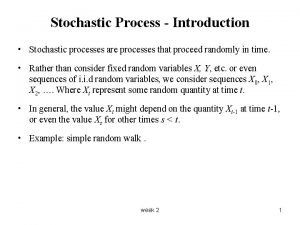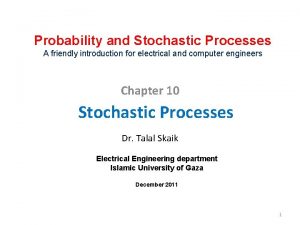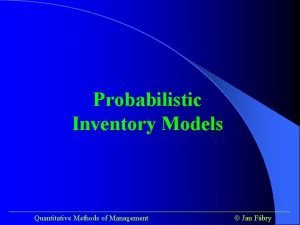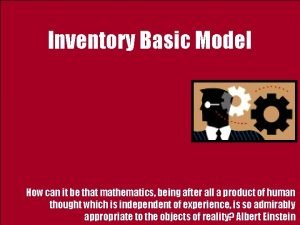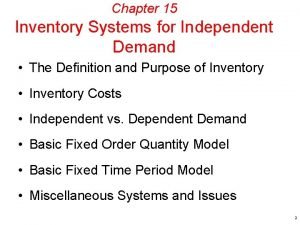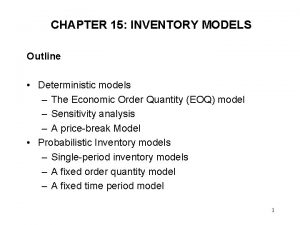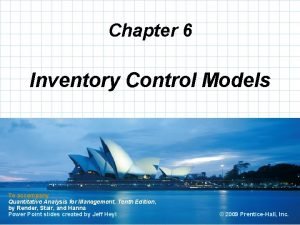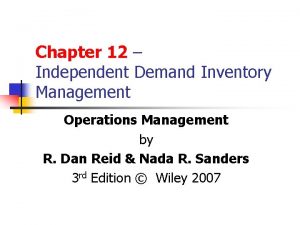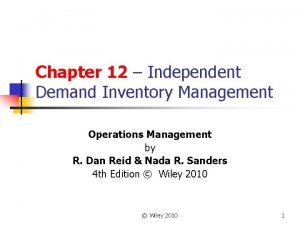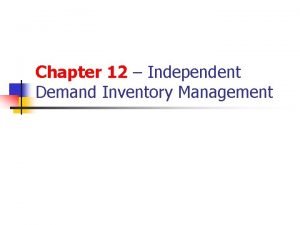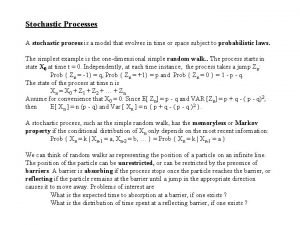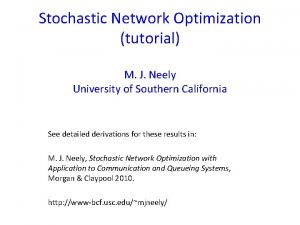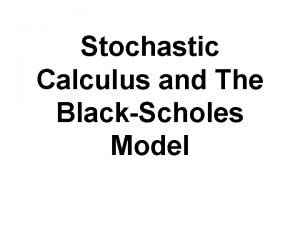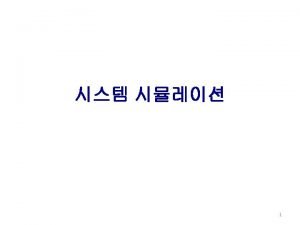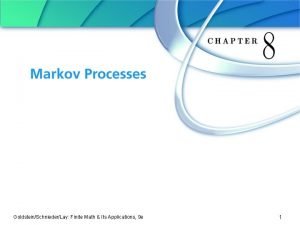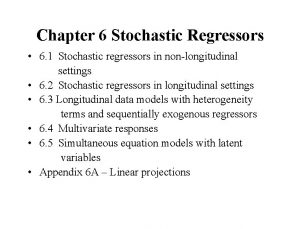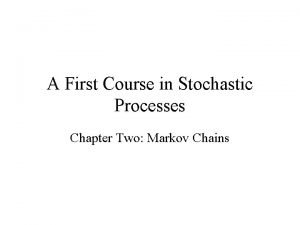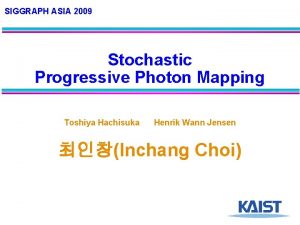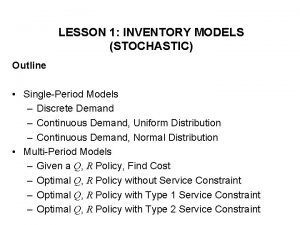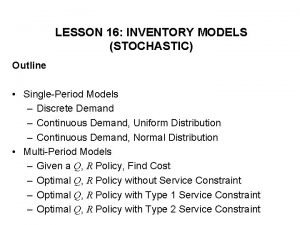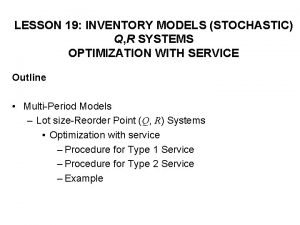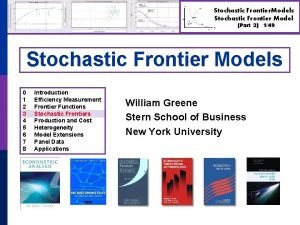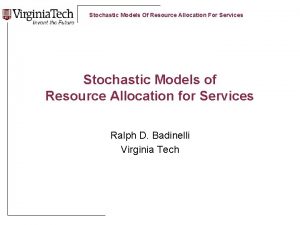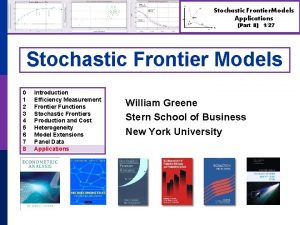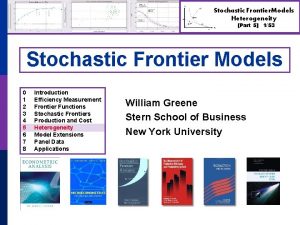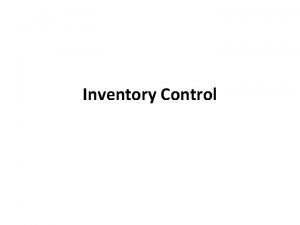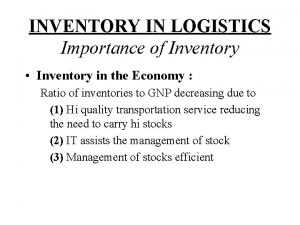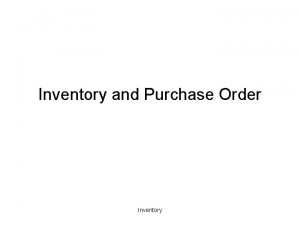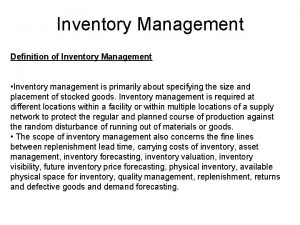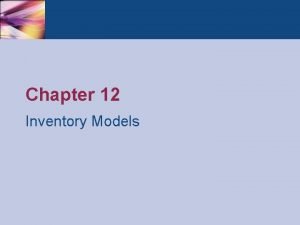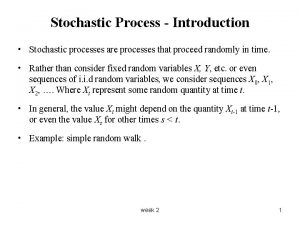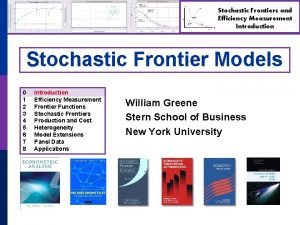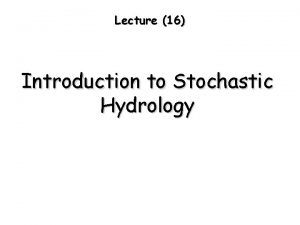LESSON 17 INVENTORY MODELS STOCHASTIC INTRODUCTION TO THE
























- Slides: 24

LESSON 17: INVENTORY MODELS (STOCHASTIC) INTRODUCTION TO THE Q, R SYSTEMS Outline • Multi-Period Models – Lot size-Reorder Point (Q, R) Systems – Notation, Definition and Some Formula – Example: Given a Q, R Policy, Find Cost

Lot Size - Reorder Point (Q, R) Systems • In the simple EOQ model, demand is known and fixed. However, often demand is random. The lot sizereorder point (Q, R) systems allow random demand. • There are two decision variables in a (Q, R) system: – Order quantity, Q and – Reorder point, R • The Q, R policy is as follows: – When the level of on-hand inventory hits reorder point, R place an order with lot size Q.

Lot Size - Reorder Point (Q, R) Systems • In the simple EOQ model, R is the demand during the lead time. • However, in presence of random demand, R usually includes a safety stock, in addition to the expected demand during the lead time. So, Reorder point, R = lead-time demand + safety stock

Lot Size - Reorder Point (Q, R) Systems • In the simple EOQ model, only holding cost and ordering costs are considered. • In presence of random demand, the demand may sometimes be too high and exceed the inventory on hand. The result is stock-out. • For each unit of shortage, a penalty cost p is charged. See Lesson 16 for more information on penalty cost. Penalty cost = p per unit.

Lot Size - Reorder Point (Q, R) Systems • The goal of a lot size-reorder point system is to find Q and R so that the total annual holding cost, ordering cost and stock-out cost is minimized. • The current lesson only covers how to compute cost from a given policy. • The next three lessons address the question how to find optimal Q and R so that the total annual cost is minimized.

Lot Size - Reorder Point (Q, R) Systems Whenever the inventory on hand hits R, a quantity Q is ordered.

Lot Size - Reorder Point (Q, R) Systems Too high lead-time demand may cause stock-outs. Safety stock reduces the chance of stock-outs.

Lot Size - Reorder Point (Q, R) Systems The reorder point is computed from the lead-time demand the safety stock. Lead-Time Demand Safety Stock

Lot Size - Reorder Point (Q, R) Systems Goal: Find Q and R such that total annual holding cost, ordering cost and stock-out cost is minimized. Lead-Time Demand Safety Stock

(Q, R) Policy Notation, Definition and Some Formula

(Q, R) Policy Notation, Definition and Some Formula

(Q, R) Policy Notation, Definition and Some Formula

(Q, R) Policy Notation, Definition and Some Formula

(Q, R) Policy Notation, Definition and Some Formula

(Q, R) Policy Notation, Definition and Some Formula • Type 1 service – Type 1 service level, is the probability of not stocking out during the lead time. – F(z) is available from Table A-4, pp. 781 -786 • Type 2 service – Type 2 service level is measured by fill rate, which is the proportion of demands that are met from stock

Example - Given A Q, R Policy, Find Cost Annual demand for number 2 pencils at the campus store is normally distributed with mean 2, 000 and standard deviation 300. The store purchases the pencils for 10 cents and sells them for 35 cents each. There is a twomonth lead time from the initiation to the receipt of an order. The store accountant estimates that the cost in employee time for performing the necessary paper work to initiate and receive an order is $20, and recommends a 25 percent annual interest rate for determining holding cost. The cost of a stock-out is the cost of lost profit plus an additional 20 cents per pencil, which represents the cost of loss of goodwill. Currently, a (Q, R) system with Q = 1500, R = 500 is used.

Example - Given A Q, R Policy, Find Cost Find a. The safety stock Lead time, t = Lead - time demand, m = lt = Safety stock = R - m =

Example - Given A Q, R Policy, Find Cost b. The average inventory level Average inventory = Q Q + safety stock = + R - m 2 2 = c. The expected annual number of orders l Expected annual number of orders or cycles = Q =

Example - Given A Q, R Policy, Find Cost d. The probability of not stocking out during the lead-time R -m = z= s Probability of not stocking out during lead - time = F (z ) = (See Table A - 4, pp. 781 - 786) e. The expected number of units stock-out per cycle n = s. L(z ) = = (See Table A - 4, pp. 781 - 786)

Example - Given A Q, R Policy, Find Cost f. The fill rate, = 1 - n = Q g. The expected annual number of shortages nl Expected annual number of shortages = Q =

Example - Given A Q, R Policy, Find Cost h. The holding cost per unit per year and penalty cost per unit. Holding cost, h = Ic = Penalty cost, p =

Example - Given A Q, R Policy, Find Cost i. The average annual holding cost associated with this policy. Annual holding cost, regular h. Q = = 2 Annual holding cost, safety stock = h( R - m) = Total annual holding cost =

Example - Given A Q, R Policy, Find Cost j. The total annual cost associated with this policy. Kl = Annual ordering cost = Q npl = Annual stock - out cost = Q h. Q Kl npl + h( R - m) + + Total annual cost = 2 Q Q =

READING AND EXERCISES Lesson 17 Reading: Section 5. 4, pp. 259 -262 (4 th Ed. ), pp. 250 -254 (5 th Ed. ) Exercise: 13 b (use the result of 13 a), p. 271 (4 th Ed. ), p. 261 (5 th Ed. )
 Inventory modeling
Inventory modeling Deterministic and stochastic inventory models
Deterministic and stochastic inventory models Stochastic process introduction
Stochastic process introduction Introduction to stochastic processes pdf
Introduction to stochastic processes pdf Inventory model in quantitative techniques
Inventory model in quantitative techniques Most inventory models attempt to minimize
Most inventory models attempt to minimize Independent demand inventory system
Independent demand inventory system Independent demand examples
Independent demand examples Is inventory a stock
Is inventory a stock Inventory control model
Inventory control model Inventory models for independent demand
Inventory models for independent demand Independant demand
Independant demand What is independent demand
What is independent demand Difference between model and semi modals
Difference between model and semi modals Stochastic rounding
Stochastic rounding Stochastic programming
Stochastic programming Stochastic process model
Stochastic process model Divbar
Divbar Put call formula
Put call formula Stochastic vs dynamic
Stochastic vs dynamic Stochastic matrix
Stochastic matrix Regressors meaning
Regressors meaning Non stochastic theory of aging
Non stochastic theory of aging A first course in stochastic processes
A first course in stochastic processes Stochastic progressive photon mapping
Stochastic progressive photon mapping


